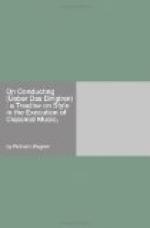It is needless to discuss the aesthetic problems Schiller touches upon. It is enough to state here that I take Mozart’s quick Alla-breve movements as representative of the naive Allegro. The Allegros of the overtures to his operas, particularly to “Figaro” and “Don Giovanni” are the most perfect specimens. It is well known that Mozart wished these pieces to be played as fast as possible. Having driven his musicians into a sort of rage, so that to their own surprise they successfully rendered the unheard of Presto of his overture to “Figaro,” he commended them, saying: “that was beautiful! Let us take it still quicker this evening.” Quite right. As I have said of the pure Adagio that, in an ideal sense, it cannot be taken too slowly, so this pure unmixed Allegro cannot be given too quickly.
The slow emanations of pure tone on the one hand, and the most rapid figurated movement on the other, are subject to ideal limits only, and in both directions the law of beauty is the sole measure of what is possible. The law of beauty establishes the point of contact at which the opposite extremes tend to meet and to unite. The order of the movements in the symphonies of our masters—from the opening Allegro, to the Adagio, and thence by means of a stricter dance-form (the Menuet or Scherzo), to the quickest Allegro (Finale)—shows a perfect sense of fitness. To my mind, however, there are signs of a deterioration of the sense of fitness when composers exhibit their platitudes in the Suite [footnote: Compare Franz Lachner’s Suites for Orchestra.] and attempt to bolster up that old form, with its less thoughtfully arranged succession of typical dance tunes; for these have been fully developed elsewhere, and have already been embodied in far richer, more extensive and complex forms.
Mozart’s absolute Allegros belong to the naive species. As regards the various degrees of power of tone (Nach der Seite der Dynamik hin) they consist of simple changes of piano and forte; and, as regards structure they show certain fixed and stable rhythmic melodic traits (Formen) which, without much choice or sifting, are placed side by side, and made to chime with the changes of piano and forte; and which (in the bustling ever-recurring semi-cadences) the master employs with more than surprising ease. But such things—even the greatest negligence (Achtlosigkeit) in the use of common-place phrases and sections— are explicable and excusable from the nature of this sort of Allegro, which is not meant to interest by means of Cantilena, but in which the restless incessant movement is intended to produce a certain excitement. It is a significant trait in the Allegro of the overture to Don Giovanni that this restless movement ends with an unmistakable turn towards the “sentimental.” Here—where the extremes meet, at the point of contact indicated above—it becomes necessary to modify the tempo in the bars leading from the overture to the




